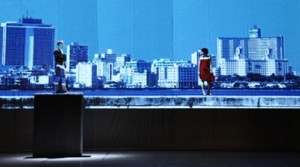JACOB’S PILLOW DANCE FESTIVAL
DanzAbierta
Ted Shawn Theatre
July 13-17, 2011
Review by Anna Rogovoy
(BECKET, Mass., July 14, 2011) – In an engagement marking its highly anticipated U.S. debut, DanzAbierta, Cuba’s most significant contemporary dance ensemble, performed at Jacob’s Pillow last night. Comprised of five dancers, DanzAbierta was discovered by Pillow director Ella Baff during a whirlwind visit to Havana, where she saw approximately 30 companies in 5 days, somehow remaining “alert enough to see that this company was really something special.”
MalSon, by the company’s resident choreographer, Susana Pous, opens with projected credits in the style of a movie, and the dramatic flair that its performers bring to its execution lives up to this premise. The two men and three women of DanzAbierta are physically bravura. They fly through jumps, turns, and lifts with vigor and a palpable sense of daring — and, in the case of the women, high-heeled shoes. Each one radiates power in a series of athletic, physically challenging duets. Particularly captivating from the very beginning are the pair of Marilyn Castillo and Yoan Matos, whose space-eating lunges and expressive faces contrast the less sensual, sharper duo of Yaima Cruz and Abel Berenguer. Cruz in particular is at times explosively knifelike, notably during a sequence where she moves from one performer to another, vamping and demanding attention from their blank presences.
Several times throughout the hour-long work one or more of the dancers wears a glassy, unrecognizing expression. At times this choice seems very deliberate and effective, as when Matos and Berenguer transform into frozen dolls that Castillo and Saro Silva move around and dance with; at others, it seems more like a lack of direction. Silva in particular looks unsettlingly deadpan during a number of otherwise exciting moments. Otherwise an excellent performer, this blank countenance sets Silva apart as less engaged and, to an extent, less engaging.
Pous relies heavily on the impressive, almost acrobatic abilities of these dancers. And what abilities they are: Matos twirls Castillo over his head seemingly effortlessly, and each takes a turn climbing onto and jumping or “falling” off of a large gray block that reaches well over their heads. This is the sort of exhilarating, heart-pumping stuff that we expect from a program billed as a “love letter to Havana”. But what might have better filled that role would have been a work in which these dancers were allowed to explore subtlety, nuance, and a more sensitive range of emotion. They exude passion for what they do; rather than challenging their bodies, which are clearly capable of fantastic physicality; Pous ought to tap further into their emotional capacities.
Anna Rogovoy is chief dance critic for The Rogovoy Report. She studies dance, writing, and literature at Bennington College.

